If you want to learn about vegan foods, the best place to start is not with cooking, but with eating. Transitioning to a vegan diet is remarkably easy once you spend a little time reading about all there is to eat. This article will introduce you to a diverse assortment of delicious vegan foods.
Eating Vegan is Easy
Omnivores frequently ask vegans, palms upturned in bafflement, “What on earth do you eat?” The implication here is that vegan diets contain only a narrow and monotonous assortment of foods. Fortunately, nothing could be further from the truth.
If you want to incorporate more vegan foods into your life, you are in for a pleasant surprise. In this guide, I’m going to introduce you to a staggering variety of delicious vegan foods.
Most food-related publishing and television is devoted to cooking. And while cooking is important, the vegan dishes you can prepare yourself are only a subset of everything you can potentially eat. In this guide we’ll look beyond cooking to explore every possible category of vegan food. If you fear that eating vegan would prove restrictive and limiting, prepare for a pleasant surprise. We’re about to discover an endless variety of sensational vegan foods!
Let’s start by looking at every category of food produced by plants. After that, we’ll explore the wide assortment of vegan-friendly cuisines. Next, I will introduce you to vegan meals you can cook at home, including seven key dishes that require minimal prep time. In case you want to dive deeper into vegan cooking, I’ll toss out a few solid cookbook recommendations. I will wrap up this piece with advice for vegan grocery shopping, eating out, and travel. Along the way I’ll include tons of links for more detailed coverage of the key topics this article covers.
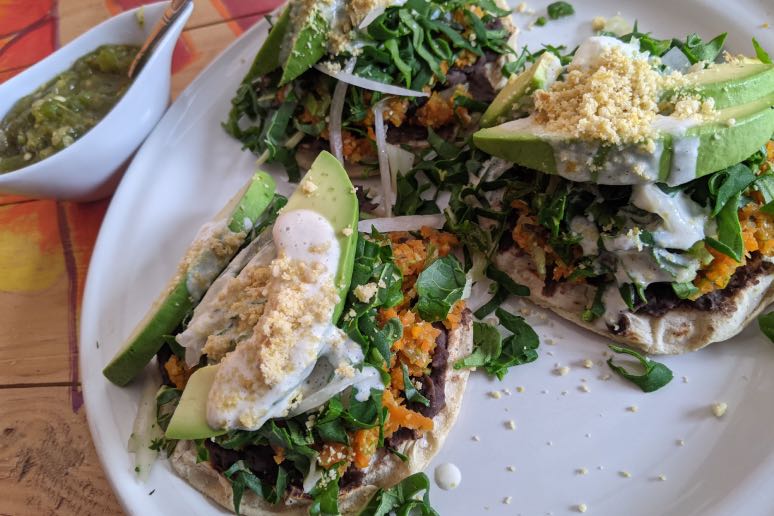
The Best Vegan Foods for Everyday Eating
The idea of going vegan once struck me as absurdly difficult, but the experience proved ten times easier than I imagined. My diet today is far more diverse and delicious than it ever was when I ate meat. As you start eating more vegan foods, you’ll soon be overwhelmed by all the delicious possibilities.
Vegan diets need never be expensive. Even the simplest meals can bring sensational flavors. I don’t think I’ve ever had an expensive gourmet meal surpass the flavors of a perfectly ripe avocado on an excellent sourdough baguette. If you have an eye for quality, you can eat exceptionally well on a budget. After all, freshness and perfect ripeness never cost extra money—they merely require that you pay more attention when food shopping.
Vegan foods come in practically limitless variety—you could try something new every day for the rest of your life. What’s more, new foods are coming to market all the time. As long as it’s from a plant, it’s fair game. That means a vegan diet lets you eat every sort of food made from vegetables, fruits, grains, beans, nuts, and seeds. Let’s quickly explore each of these possibilities:
Vegetables
Vegetables deliver peak flavor when purchased in season. A handful come into season in the spring. Most vegetables are harvested during the summer. And then a few more important varieties are ready for harvest at the very end of autumn.
Since pea plants thrive in cool weather, peas are among the first crop harvested. They come into season by mid spring. Spring is also when cabbage, broccoli, spinach, and most lettuces come to market.
In early summer, kale and chard become available, along with cucumbers and summer squash. They say you shouldn’t pick corn until the water’s boiling, and it’s during the hottest days of summer when corn reaches its peak.
Root vegetables are harvested when the nights turn nippy. These vegetables include carrots, potatoes, parsnips, beets, yams, and sweet potatoes. All of these foods are perfect for hearty winter stews that’ll take you through the coldest weather.
Since they are among the most nutritious foods you can eat, you’ll definitely want to read our guide to vegetables. You’ll also benefit from reading our pages on how to make a killer stir-fry, and how to roast vegetables in the oven.
Mushrooms
Mushrooms are neither a fruit nor a vegetable, and are available year-round. Asians and especially the Japanese eat an incredible assortment of mushrooms.
For my money, the tastiest mushroom of all is a Japanese mushroom called shiitake that grows only on wood. It’s got a subtle flavor and a meaty texture that—once sauteed with garlic—makes it the ideal filling for spring rolls and dumplings. Just make sure to discard the stems of shiitakes since they’re woody and inedible.
Asian groceries offer a wider selection of mushrooms than anyplace else, so check if there’s one near you.
Fruits
Fruit comes in endless varieties. Whenever possible, buy local and in season. Tree-ripened peaches purchased at your local orchard will be far more delicious than their counterparts grown hundreds of kilometers away. A farmer’s market, or the farm itself, is invariably the best place to buy fruits and vegetables.
One revelation you’ll gain by diving deeper into good eating is that most fruit should not be available year-round. If the best you can get is a Florida grown winter tomato, you’re better off making something else and doing without tomatoes altogether. Of course, canned tomatoes work wonderfully for many purposes and they are always picked at peak ripeness.
Frozen fruit plus vegan milk makes wonderful, nutritious, and easy-to-make smoothies. And since frozen fruit is always widely available, you can enjoy smoothies any time of year. Check out our tips for making a fantastic smoothie.
Dried fruit offers a sensational way to enjoy the flavors of summer during the middle of winter. And dried fruit delivers far more concentrated flavors than fresh.
For more ideas on how to incorporate delicious fruits into your diet, see our guide to fruits.
Grains
Whole grains are remarkably nutritious. They’re also among the cheapest available sources of calories. When possible, purchase only whole grains and unrefined flours, since these choices are far more nutritious than processed grains.
You’ll find the best prices and the widest selection either online or at your natural food store’s bulk department. There you can find rice, wheat, oats, corn, rye, and millet. You can also buy buckwheat and quinoa, which are classified as pseudo cereals, since they are botanically seeds rather than grains.
Rice is the most popular grain for billions of people. Be sure to buy multiple varieties, including red and purple. Also keep in mind that quinoa (pronounced: keen-wah) has far more protein and nutrients than rice, and requires much less water to grow.
Any sort of bread or breakfast cereal is grain-based. Granola is super easy to make, and straight out of the oven it invariably tastes better than any commercial brand. If you don’t have a good natural foods store nearby, you can buy packaged Bob’s Red Mill grains from Amazon.com. Their product line is extensive, reasonably priced, and mostly organic.
Beans
Beans are by far the cheapest and most nutritious food on the planet, especially when purchased in dried form. Like grains, the best and cheapest way to buy beans beans is either at your natural foods store’s bulk department or online. If time is scarce, you can use canned beans, which taste fine but are not as tasty as dried beans you cook yourself. You can improve their flavor by sauteing chopped onions in a little oil before heating up your canned beans.
The best way to cook beans is in an Instant Pot or pressure cooker, since otherwise your beans can take upwards of two hours to properly cook. If you’re new to cooking beans, the best entry point is an Indian-style dal made with lentils or mung beans. This is a quick and easy dish to make, and is wonderful either as a soup or served over rice.
There are dozens of varieties of beans. Trying as many kinds as possible is one of the easiest ways to diversify your diet. Consult our bean guide for comprehensive information on purchasing, cooking, and enjoying beans.
Nuts and Seeds
Like beans, nuts and seeds contain loads of protein and minerals. Nuts are one of the world’s most convenient snacks. There’s decent evidence that eating a small handful of them every day is associated with better health. Unfortunately, nuts tend to be expensive, in large part because they grow on trees and must be laboriously picked and shelled.
Though very nut-like, peanuts aren’t actually a nut, but a legume. Peanuts are one of the best foods to cut your food costs—they’re full of nutrients yet cost next to nothing. As the expression goes, when something is absurdly cheap, you can buy it for peanuts.
Like peanuts, seeds are also much cheaper than nuts, and absolutely delicious—your choices include pumpkin, sunflower, hemp, and sesame. Spicy roasted pumpkin seeds are among the tastiest snacks you’ll ever experience. Shelled roasted hemp seeds are an exquisite salad topping.
Most varieties of nuts are available as nut butters. Every sort of nut butter is excellent on bread or toast. You can also use peanut butter or cashew butter to make a delicious sauce to serve over rice.
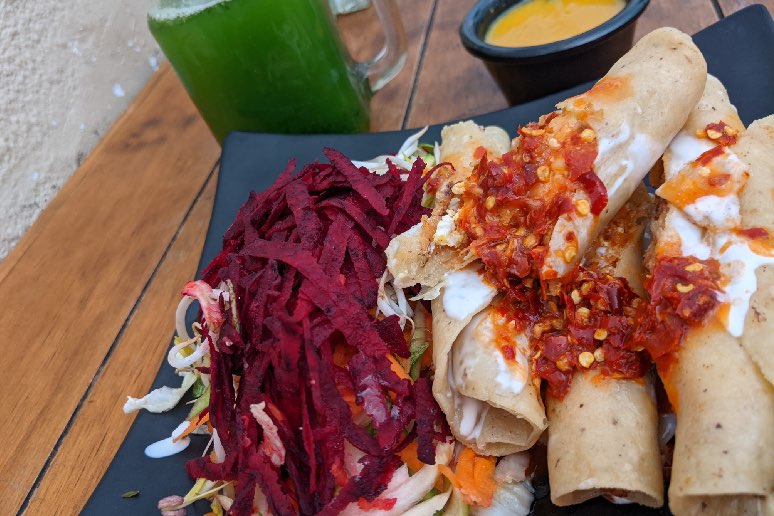
Vegan Pantry Staples
Let’s now go through the most important vegan staples. If you’re eating a vegan diet, you’ll want to keep most of these foods in your kitchen.
Oils
Oils appear in every recipe that involves frying or sautéing. They’re also the primary component of most salad dressings.
Commercially-bottled oils come from every fat-rich vegan food you can think of: seeds, olives, coconuts, and even avocados. Unrefined oils have more flavor, but scorch at lower cooking temperatures. Three oils in particular deserve permanent spots in your pantry:
- Extra Virgin Olive Oil. Perfect for any sort of low-temperature cooking, and an excellent base for salad dressings. Mix unrefined olive oil with a little balsamic vinegar to make a sensational dip for sourdough french bread.
- High Oleic Safflower Oil. A flavorless refined oil ideal for sautéing or frying. The inclusion of “high oleic” on the label indicates the oil won’t scorch at normal cooking temperatures.
- Unrefined Roasted Sesame Oil. Surprisingly inexpensive considering its rich and appealing flavors. Dash a little on your next stir-fry just before serving, or squirt some into your next batch of salad dressing.
Tofu and Tempeh
Both of these foods were invented centuries ago in Asia. Tofu is made from soy milk that’s treated with a coagulant that solidifies it into a wiggly block. Don’t let appearances fool you, since tofu is the primary ingredient in a vast assortment of delicious dishes.
Tempeh is a simpler and less-processed food, made from cooked split soybeans that have been cultivated with a fungus. You can make a delicious nature burger just by frying tempeh on each side until golden brown, and then adding ketchup or barbecue sauce.
As soy products, both tofu and tempeh are full of protein. They require fare less cooking and prep time than dried beans, while also being much easier to digest. On top of all these advantages, tofu made with calcium sulfate contains more than twice the calcium per calorie as whole cows’ milk.
All these qualities make tofu and tempeh fantastic protein choices for your next stir-fry. Please see our tofu and tempeh guides for all sorts of recipe ideas.
Nut Butters
If you like peanut butter, why stop there? Branch out and try every other nut butter you can find. Try spreading cashew butter on a toasted sourdough baguette and topping it with thinly-sliced sauteed leeks. I have never eaten a more delicious simple meal.
Any nut butter can become a magnificent sauce. Just blend and gently heat with a little coconut milk, soy sauce, and minced sautéed garlic and ginger. Then squirt in a little lemon or lime juice before serving.
Seasonings
Do you enjoy flavorful or spicy foods? If so, vegan cooking offers unlimited possibilities to season things up, since all herbs and spices come from plants.
Additionally, the overwhelming majority of sauces and condiments are also vegan. These include all or most:
- Soy sauce, including tamari
- Hot sauce, both gourmet and dirt-cheap
- Ketchup
- Mustard
- Vinegar (including apple cider, red wine, balsamic, and rice)
- Sriracha “rooster” sauce
- Indian-style pickle pastes
- Wasabi paste
- Barbecue sauce (great on grilled tofu or tempeh)
- Mexican fresh or jarred salsas
There are some non-vegan brands of the sauces above, so always read the ingredients. But most of these products are vegan.
The one big no-no for vegans is Worcestershire sauce, which usually contains anchovies. But there are a couple vegan brands and you can also make your own from scratch. Also, some soy sauces—several Japanese brands in particular—contain fish extract.
The most popular seasoning combination throughout Asia is minced garlic and ginger. It’s an especially wonderful addition to stir-fries, and will take many of your favorite dishes to the next level.
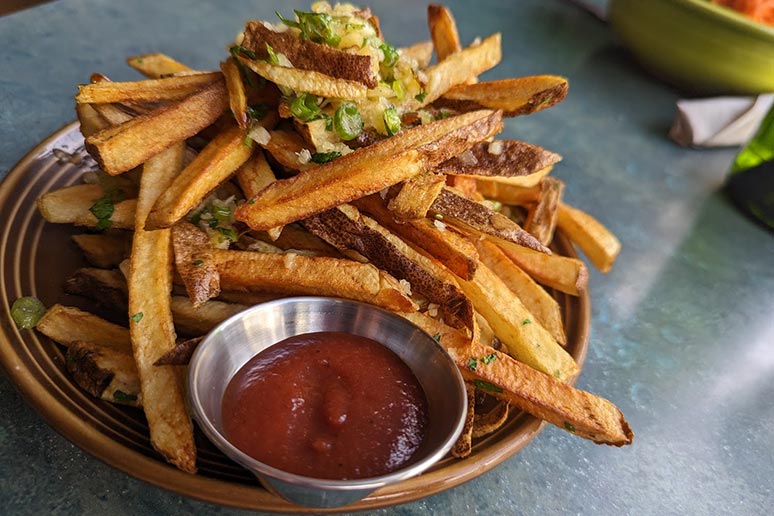
Grocery Shopping
A good natural food store always beats a supermarket in its sheer variety of vegan foods. But even a mediocre supermarket will offer a large selection of fresh fruits and vegetables, plus a comprehensive selection of vegan pantry items.
When shopping at natural food stores, always visit the deli counter. Unlike a supermarket deli counter, you will find plenty of vegan offerings. The deli offers an amazing way to discover new vegan foods without having to spend time cooking.
If you don’t have a good natural foods store nearby, the vegan groceries sold by Amazon.com can close the gap. We publish a helpful page listing all of Amazon’s best deals on vegan groceries.
Vegan Supermarket Staples
Supermarkets and natural food stores carry all sorts of ready-to-eat and heat-and-eat items, often at excellent prices. Many of these items are probably already in your pantry or freezer. They include:
- Crackers and Flatbreads—Triscuits and Finn Crisp crackers are wholegrain, vegan, and sold everywhere.
- Cereal—Many brands are vegan, whole grain, and organic. Lightly-sweetened puffed rice is especially underrated.
- Oatmeal & Porridge Mixes—Nothing’s more satisfying on a cold morning, and this breakfast is filling, nutritious, and ridiculously cheap.
- Cookies—Few cookies sold at supermarkets are vegan, but you’ll find many vegan varieties at natural foods stores.
- Breads and English Muffins—Oddly, whole grain is more likely to contain dairy products or honey.
- Energy Bars—Clif Bar, Probar, Larabar, and NuGo are all vegan.
- Wheat Tortillas—Delicious spread with hummus, used for vegan quesadillas, or for any sort of wrap.
- Pasta—Dried spaghetti is always vegan. Other pasta varieties may contain egg products.
- Asian Noodles—Asian “rice stick” noodles are cheap and always vegan, and make a superb vegan Pad Thai.
- Frozen Dinners—There are too many varieties to mention, including pizza and vegan mac & cheese.
- Tomato Sauce—Newman’s marinara sauce is widely available and vegan.
- Canned Beans—Baked beans are cheap and delicious.
- Pickles and Olives—Upscale markets usually have an olive bar, and all supermarkets sell jarred pickles and olives.
- Hummus—You can find tubs of hummus in the dairy case of any supermarket.
- Frozen Vegetables—Enable you to cook with high-quality vegetables year-round.
- Chips—Many potato chips and corn chips are vegan.
- Tater Tots—Junky but delicious.
- Dark Chocolate—Fair-trade vegan chocolate is sold at most natural food stores and some supermarkets.
- Coffee and Tea
- Frozen Fruit—Inexpensive and ideal for making smoothies in your blender with your favorite vegan milk.
- Salad Dressings—Vegan brands are widely available, but you’re better off making your own.
When it comes to the above products, you’ll find more vegan brands in a natural foods store than at a supermarket. That’s especially the case when it comes to cookies, chips, and frozen convenience foods.
Avoiding Animal-Based Ingredients
You can never be sure a packaged food is vegan until you read the label.
Some animal ingredients are obvious, like milk and egg whites. But there are also a bunch of widely-used ingredients you’d never guess come from animals. To familiarize yourself with the more obscure non-vegan ingredients, check out our animal ingredients page.
Meat, Dairy, Egg Alternatives
Whichever animal-based foods you enjoy, you can find terrific replacements for them on our vegan alternatives page. Vegan food companies make delicious vegan burgers, sausages, turkey, and more.
If you love dairy products, every sort of vegan alternative is widely available, including cheese, yogurt, butter, and even sour cream. One reason milk is so easy to quit is that most people don’t particularly enjoy its flavor. Many vegan milk brands deliver more calcium and protein than cows’ milk, and taste better too.
Vegan egg alternatives are likewise easy to find. If you’re merely looking to replace eggs in baking (say, for pancakes or banana bread), all you need is a cheap box of egg replacer. This product provides the similar binding properties to egg whites. If you’re actually seeking the texture and flavor of real eggs to make scrambled eggs or an omelet, go with a product like Just Egg or The Vegg. Whatever you are baking or cooking, there’s a vegan egg alternative that’s perfect for the job. For complete coverage, see our guide to vegan egg replacers
Cooking
Vegan cooking throws open the doors to maximizing the pleasure you get from eating. If you’re craving a particular meal, you can always make it yourself. And every dish can be spiced and seasoned just the way you like it.
Perhaps no skill will give you as much pleasure as learning to cook vegan. And it’s so easy to learn. Our comprehensive guide to vegan cooking offers the perfect introduction for novice cooks.
You only need the most basic equipment to get started. If your kitchen isn’t well-equipped, we offer helpful recommendations covering the most valuable kitchen items for vegans.
Considering the hundreds of vegan cookbooks available, where should you start? Surprisingly, the easiest way to dive into vegan cooking does not involve following recipes. Instead, just learn how to prepare these easy meals:
- Oven Roasted Vegetables
- Sandwiches and Wraps
- Bowls
- Fruit Smoothies
- Stir-Fried Vegetables
- Salads
- Soups
Of the above dishes, only stir-fried vegetables require significant practice. But stir-fries are so delicious—and you can make them so many variations—that they’re well worth taking time to master.
Vegan-Friendly Cuisines and Cookbooks
The world’s most popular cuisines offer countless classic dishes that just happen to be vegan. If you’re looking to experiment with new styles of cooking, I’ve written several guides to the most vegan-friendly cuisines. Each guide highlights the most vegan-friendly menu items at restaurants and also provides guidance for cooking at home.
You will have no problem finding vegan recipes for the foods you enjoy most. Our vegan cookbooks guide features more than a dozen regional titles that each specialize in a different cuisine.
The less complicated your meals, the more cooking you’ll do. So, when purchasing your first vegan cookbook, select a title that focuses on simple, nutritious, quickly-prepared recipes. JL Fields’ Fast & Easy Vegan Cookbook is the perfect first title for aspiring vegan cooks. You can make many of its recipes in no more time than it takes to heat up a frozen dinner.
Finally, if you have a sweet tooth, you’ll find no scarcity of vegan dessert possibilities. There are numerous vegan dessert cookbooks in print, including titles that specialize exclusively in vegan ice cream, cupcakes, cookies, and pie.
How to Eat Vegan at Restaurants
You’ll have no problem finding restaurants with terrific vegan offerings. Just use your phone to query Google using the phrase, “vegan food near me.” You’ll discover all sorts of excellent vegan offerings at both vegan and non-vegetarian restaurants.
If you don’t have a good vegan restaurant nearby, your best bet is a Lebanese or Israeli restaurant. Falafel, hummus, pita, and tabbouleh are delicious, healthy, and reliably vegan. Ethiopian restaurants are also remarkably vegan-friendly if you stick to injera bread and vegetarian stews. Most pizzerias are likewise vegan-friendly if you stick to veggie toppings and leave off the cheese. Oddly, though, many large pizza chains put dairy in their dough—but this flies in the face of traditional pizza-making. Very few independently-owned pizzerias adulterate their dough with milk products.
Although Chinese restaurant food often contains non-vegetarian ingredients, the PF Chang’s chain offers a vegetarian menu. All their vegetarian options are vegan, although a small amount sugar processed with bone char appears in many of these dishes.
Vegan Fast Food
For decades, fast food chains did practically nothing accommodate vegans. But now, these companies are racing one another to add vegan offerings. Most notably, in 2019 Burger King launched its “Impossible Whopper” to great success (vegans should order it without mayonnaise). Most of the big Mexican chains, including Chipotle, Qdoba, Taco Del Mar, and Taco Bell offer solid vegan options.
For more extensive coverage of this topic, see our fast food guide and our vegan dining guide.
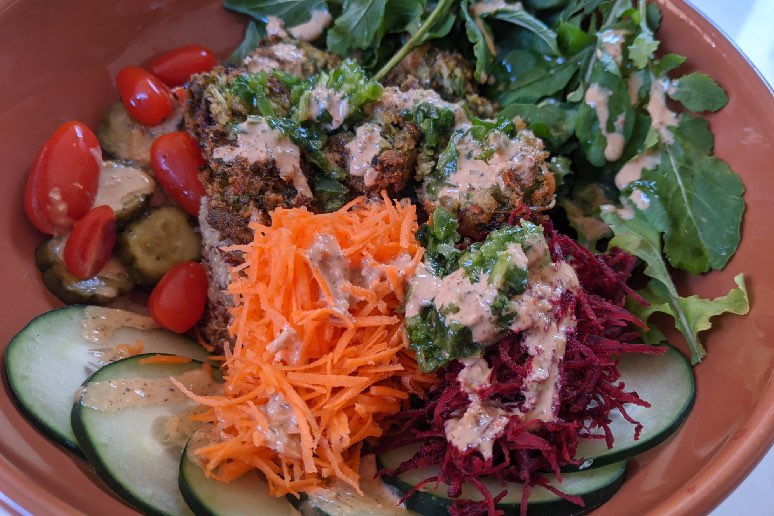
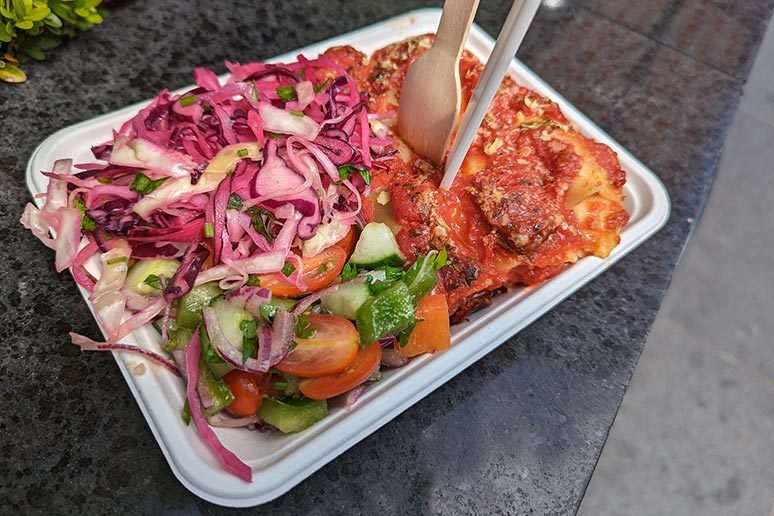
2 thoughts on “EATING VEGAN: GROCERY SHOPPING COOKIES & 20 DINNING OPTIONS”